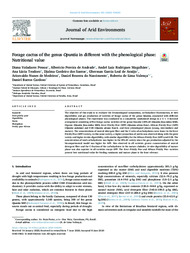Forage cactus of the genus Opuntia in different with the phenological phase: nutritional value.
Forage cactus of the genus Opuntia in different with the phenological phase: nutritional value.
Author(s): PESSOA, D. V.; ANDRADE, A. P. de; MAGALHÃES, A. L. R.; TEODORO, A. L.; SANTOS, D. C. dos; ARAUJO, G. G. L. de; MEDEIROS, A. N. de; NASCIMENTO, D. B. do; VALENÇA, R. de L.; CARDOSO, D. B.
Summary: The objective of this study is to evaluate the bromatological composition, carbohydrate fractionation, in vitro digestibility and gas production of varieties of forage cactus of the genus Opuntia, associated with different phenological phases. The experiment was conducted in a completely randomized design in a 5 × 3 factorial arrangement consisting of five forage cactus varieties of the genus Opuntia ((IPA-20 (Opuntia ficus-indica Mill), Gigante (Opuntia ficus-indica Mill), Erect Prickly Pear (EPP) (Opuntia stricta Haw), African Prickly Pear (APP) (Opuntia undulata) and F-08 (Opuntia atropes Rose)). and three phenological phases (young, intermediate and mature). The concentrations of neutral detergent fiber and the C ratio of carbohydrates were lower in the Erect Prickly Pear (EPP) variety, in this same variety, a higher proportion of pectin was observed along with the giant variety and higher in vitro digestibility, with similar digestibility for the African Prickly Pear (APP) and F-08. The concentration of total carbohydrates was higher in the IPA-20 variety since the gas production adjusted by the bicompartmental model was higher for APP. Was observed in all varieties greater concentration of neutral detergent fiber and the C fraction of the carbohydrates in the mature cladodes. In vitro digestibility of mature phase was also superior in all varieties except APP. The Erect Prickly Pear and African Prickly Pear varieties present best nutritional value for feeding ruminants and mature phase is the least relevant.
Publication year: 2020
Types of publication: Journal article
Unit: Embrapa Semi-arid Region
Observation
Some of Embrapa's publications are published as ePub files. To read them, use or download one of the following free software options to your computer or mobile device. Android: Google Play Books; IOS: iBooks; Windows and Linux: Calibre.
Access other publications
Access the Agricultural Research Database (BDPA) to consult Embrapa's full library collection and records.
Visit Embrapa Bookstore to purchase books and other publications sold by Embrapa.

